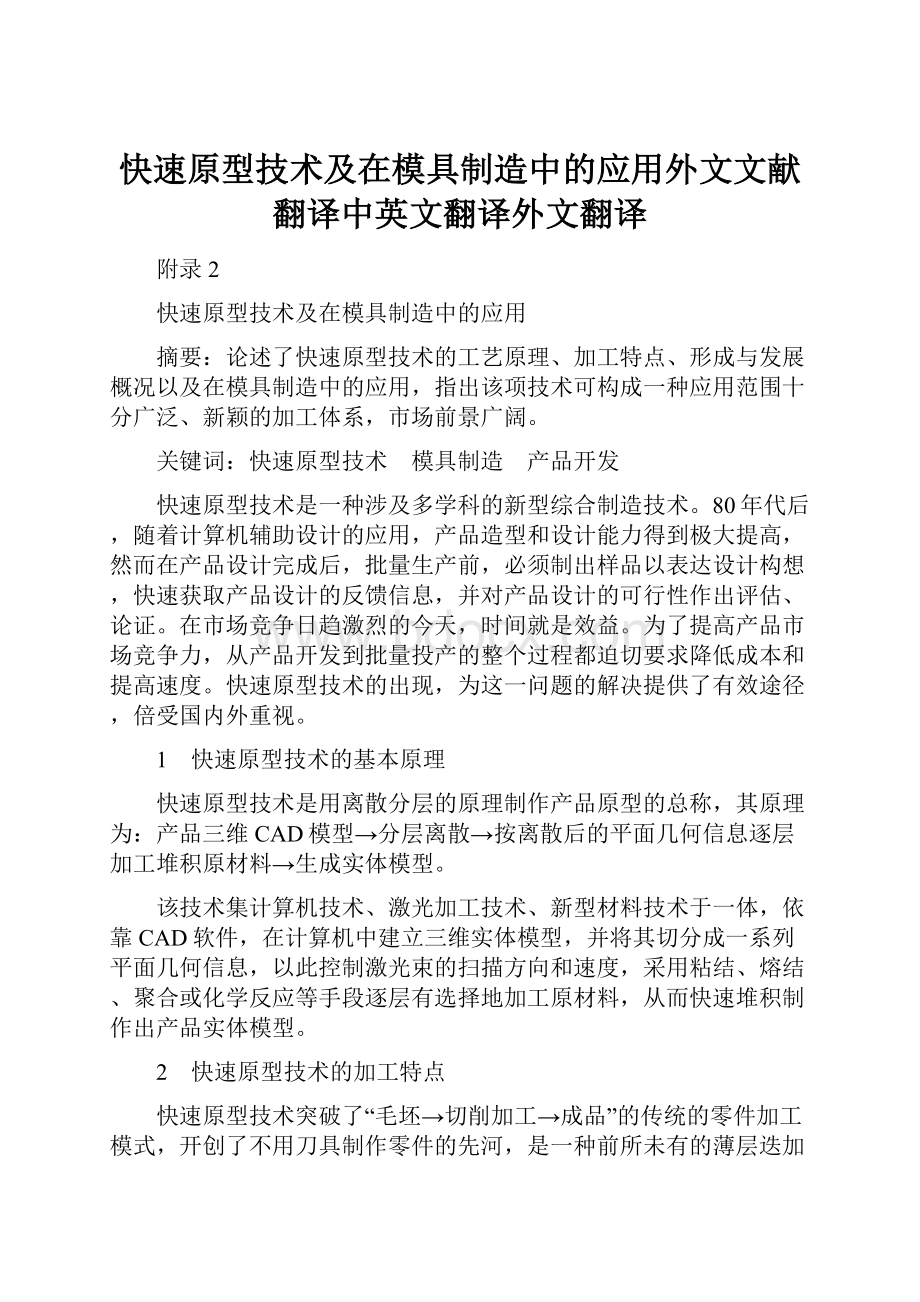快速原型技术及在模具制造中的应用外文文献翻译中英文翻译外文翻译.docx
《快速原型技术及在模具制造中的应用外文文献翻译中英文翻译外文翻译.docx》由会员分享,可在线阅读,更多相关《快速原型技术及在模具制造中的应用外文文献翻译中英文翻译外文翻译.docx(12页珍藏版)》请在冰豆网上搜索。

快速原型技术及在模具制造中的应用外文文献翻译中英文翻译外文翻译
附录2
快速原型技术及在模具制造中的应用
摘要:
论述了快速原型技术的工艺原理、加工特点、形成与发展概况以及在模具制造中的应用,指出该项技术可构成一种应用范围十分广泛、新颖的加工体系,市场前景广阔。
关键词:
快速原型技术 模具制造 产品开发
快速原型技术是一种涉及多学科的新型综合制造技术。
80年代后,随着计算机辅助设计的应用,产品造型和设计能力得到极大提高,然而在产品设计完成后,批量生产前,必须制出样品以表达设计构想,快速获取产品设计的反馈信息,并对产品设计的可行性作出评估、论证。
在市场竞争日趋激烈的今天,时间就是效益。
为了提高产品市场竞争力,从产品开发到批量投产的整个过程都迫切要求降低成本和提高速度。
快速原型技术的出现,为这一问题的解决提供了有效途径,倍受国内外重视。
1 快速原型技术的基本原理
快速原型技术是用离散分层的原理制作产品原型的总称,其原理为:
产品三维CAD模型→分层离散→按离散后的平面几何信息逐层加工堆积原材料→生成实体模型。
该技术集计算机技术、激光加工技术、新型材料技术于一体,依靠CAD软件,在计算机中建立三维实体模型,并将其切分成一系列平面几何信息,以此控制激光束的扫描方向和速度,采用粘结、熔结、聚合或化学反应等手段逐层有选择地加工原材料,从而快速堆积制作出产品实体模型。
2 快速原型技术的加工特点
快速原型技术突破了“毛坯→切削加工→成品”的传统的零件加工模式,开创了不用刀具制作零件的先河,是一种前所未有的薄层迭加的加工方法。
与传统的切削加工方法相比,快速原型加工具有以下优点:
(1)可迅速制造出自由曲面和更为复杂形态的零件,如零件中的凹槽、凸肩和空心部分等,大大降低了新产品的开发成本和开发周期。
(2)属非接触加工,不需要机床切削加工所必需的刀具和夹具,无刀具磨损和切削力影响。
(3)无振动、噪声和切削废料。
(4)可实现夜间完全自动化生产。
(5)加工效率高,能快速制作出产品实体模型及模具。
下表为快速原型技术与传统切削方法的比较。
快速原型技术与传统切削方法比较表
3 快速原型技术的发展
快速原型技术概念即RP(RapidPrototypingTechnology)概念的提出可追朔到1979年,日本东京大学生产技术研究所的中川威雄教授发明了叠层模型造型法,1980年小玉秀男又提出了光造型法,该设想提出后,由丸谷洋二于1984年继续研究,并于1987年进行产品试制。
1988年,美国3DSystems公司率先推出快速原型实用装置—激光立体造型即SLA(StereoLightgraphyApparatus),并以年销售增长率为30%~40%的增幅在世界市场出售。
近年来,随着扫描振镜性能的提高,以及材料科学和计算机技术的发展,快速原型技术已日趋成熟,并于1994年正式进入推广普及阶段。
按照所用材料的形态与种类不同,快速原型技术目前有以下四种类型。
3.1 利用激光固化树脂材料的光造型法
光造型装置一直以美国3DSystems公司的SLA型产品独占鳌头,并形成垄断市场。
其工作原理如图1所示。
由激光器发出的紫外光,经光学系统汇集成一支细光束,该光束在计算机控制下,有选择的扫描液激光器扫描镜升降装置容器光敏树脂体光敏树脂表面,利用光敏树脂遇紫外光凝固的机理,一层一层固化光敏树脂,每固化一层后,工作台下降一精确距离,并按新一层表面几何信息使激光扫描器对液面进行扫描,使新一层树脂固化并紧紧粘在前一层已固化的树脂上,如此反复,直至制作生成一零件实体模型。
激光立体造型制造精度目前可达±0.1mm,主要用作为产品提供样品和实验模型。
此外,日本帝人制机开发的SOLIFORM可直接制作注射成型模具和真空注塑模具
图1 立体光造型技术原理图
3.2 纸张叠层造型法
纸张叠层造型法目前以Helisys公司开发的LOM装置应用最广。
该装置采用专用滚筒纸,由加热辊筒使纸张加热联接,然后用激光将纸切断,待加热辊筒自动离开后,再由激光将纸张裁切成层面要求形状,如图2所示。
图2 纸张叠层造型原理图
LOM可制作一些光造型法难以制作的大型零件和厚壁样件,且制作成本低廉(约为光造型法的1/2)、速度高(约为木模制作时间的1/5以下),并可简便地分析设计构思和功能。
3.3 熔融造型法
熔融造型法以美国Stratasys公司开发的产品FDM(FusedDepositionModelling)应用最为广泛。
工作时,直接由计算机控制喷头挤出热塑材料并按照层面几何信息逐层由下而上制作出实体模型。
FDM技术的最大特点是速度快(一般模型仅需几小时即可成型)、无污染,在原型开发和精铸蜡模等方面得到广泛应用。
3.4 热可塑造型法
热可塑造型法以DTM公司开发的选择性激光烧结即SLS(SelectiveLaserSintering)应用较多。
该方法是用CO2激光熔融烧结树脂粉末的方式制作样件。
工作时,由CO2激光器发出的光束在计算机控制下,根据几何形体各层横截面的几何信息对材料粉末进行扫描,激光扫描处粉末熔化并凝固在一起。
然后,铺上一层新粉末,再用激光扫描烧结,如此反复,直至制成所需样件。
如图3所示。
图3 选择性激光烧结原理图
SLS技术造型速度快(一般制品,仅需1天~2天即可完成)、造型精度高(每层粉末最小厚度约0.07mm,激光动态精度可达±0.09mm,并具有自动激光补偿功能)、原型强度高(聚碳酸脂其弯曲强度可达34.5MPa,尼龙可达55MPa),因此,可用原型进行功能试验和装配模拟,以获取最佳曲面和观察配合状况。
在快速原型技术的开发应用方面,美国和日本走在前列。
近年来,我国快速原型技术的发展已十分迅速。
华中理工大学在1994年开发研制成功两种快速成型系统样机HRP和RPS,目前已进入商品市场,广泛应用于汽车、玩具、航空航天、造船、军工等行业。
4 快速原型技术在模具制造中的应用
4.1 快速制模铸造
将需铸零件的CAD模型转换为快速模壳制造,按模壳每层截面的几何形状生成陶瓷模壳然后按快速熔模铸造方法即可快速制造金属零件。
此外,可将快速原型技术制作生成的样件作为铸造模具的原模,实现零件的快速铸造,其过程为:
零件CAD三维设计→计算流体动力学分析(CFD)→LOM模型制造→熔模铸造金属零件。
4.2 快速模具制造
传统的模具制造方法周期长、成本高,一套简单的塑料注塑模具其价值也在10万元以上。
设计上的任何失误反映到模具上都会造成不可挽回的损失。
快速原型技术可精确制作模具的型心和型腔,也可直接用于注射过程制作塑料样件,以便发现和纠正出现的错误。
美国爱达荷国家工程与环境试验中心采用快速凝固工艺即RSP技术实现了注塑模具的快速经济制造。
该方法采用快速原型技术制作的样件作为母体样板,通过喷涂到母体样板的金属或合金熔滴的沉积制造模具。
其工艺过程为:
熔融的工具钢或其它合金被压入喷嘴,与高速流动的隋性气体相遇而形成直径约0.05mm的雾状熔滴,喷向并沉积到母体样板上,复制出母样的表面结构形状,借助脱模剂使沉积形成的钢制模具与母样分离,即可制出所需模具。
母样使用的材料取决于喷涂其上的合金材料。
对于喷涂工具钢来说,可选用陶瓷材料,类似材料还有铝氧粉和氧化锆可供选择。
该方法制作精度高(喷涂工具钢时最小表面涂层可达0.038mm,制造精度可达±0.025mm~±0.05mm)、时间短(普通模具一周之内即可成型)、造价低(一般为传统模具制造费用的1/2~1/10)。
4.3 快速铸造模具
以聚碳酸脂为材料,用SLS快速制出母型,并在母体表面制出陶瓷壳型,焙烧后用铝或工具钢在壳内进行铸造,即得到模具的型心和型腔。
该方法制作周期不超过4周,制造的模具可生产250000个塑料制品。
5 结论
综上所述,RP是一种正在进一步发展和完善且已获得了广泛应用的高技术。
可以预见,随着CAD的广泛应用、市场竞争日趋激烈、快速造型技术本身和快速模具制造成套技术的完善,快速成形技术将发展为一种能被企业普遍采用的技术手段,并将给企业带来巨大的经济效益,这应引起各方面的高度重视。
附录3
TheRapidPrototypingManufacturinganditsapplicationinmoldingmanufacturing
Abstract:
Bydiscussingtherapidprototypingtechnologythecraftprinciple,characteristicoftheprocesses,formationandthegeneralsituationofthedevelopoffastprototypeanditsapplicationinmolding,pointoutthetechniquecanformakindofaprocesssystemofextensiveapplicationandnovel,anditsforegroundisvast.
KeyWords:
rapidprototypingtechnology;moldingmanufacturing;developmentofproduct
Rapidprototypingtechnologyisanewtypeofmultidisciplinaryintegratedmanufacturingtechnology.Afterthe1980s,followingtheapplicationofcomputer-aideddesign,productshapeanddesigncapabilitieshavegreatlyimproved,however,productdesignhascompleted,production,asystemmustbedesignedtoconveytheconceptofsamples,rapidfeedbacktoproductdesign,productdesignandassessthefeasibility,andfeasibilitystudies.Theincreasinglyfiercecompetitioninthemarkettoday,thetimeiseffective.Toenhancethecompetitivenessofproducts,fromproductdevelopmenttovolumeproductionofthewholeprocessareurgentlyrequiredtoreducecostsandincreasespeed.Rapidprototypetechnologyappearanceprovidesaneffectivesolutiontothisproblemwhichmuchattentionathomeandabroad.
1.ThebasicprincipleofRapidPrototypingTechnology
TheRPisthegenericnameoftheprinciplecreationproductprototypethatusesthelong-lostlayering,itsprincipleis:
ProduceCADmodelStratifiedseparatedaccordingtotheplangeometryinformationwhichisdispersedtopileuptheoriginalmaterialgeneratingentitymodels.
Thistechnologyintegratesofcomputertechnology,laserprocessingtechnology,newmaterialtechnology,relyingonCADsoftwareinthecreationof3Dcomputermodelsentities,andisdividedintoaseriesofplanegeometryinformationtocontrolthescanninglaserbeamdirectionandspeed,usingsinter,poolingorchemicalreactionmeansexhaustiveselectiveprocessingofrawmaterials,thusrapidaccumulationmanufactureproductsentitiesmodels.
2.ThecharacteristicsofRapidPrototypingTechnology
RapidPrototypingTechnologybreaksthetraditionalwaytoproducesparepartsof“roughcastslicetoparetoprocessfinished”,Needlesscutlerycreatedthefirstproductionofspareparts,isanunprecedentedlaminareducingprocessingmethods.Comparingtotradition,thefastprototypeprocessesthefollowingadvantage:
(1)Producethesparepartsofthecurvedfaceandmorecomplicatedappearancequickly,suchasshoulderwithinsparepartsandhollowandpartsofetc.s,consumedlyloweredthedevelopmentcostofthenewproductanddevelopmentperiod.
(2)Isanon-contactprocessing,machinetoolcuttingprocessingisnecessarycutleryandjigwithoutcutlerywearandcuttingforce.
(3)Withoutvibration,noiseandslicetoparethewaste.
(4)Cancarryoutthenighttimeoverfull-automaticproduction.
(5)Processwithhighefficiency,producesthearticleentitymodelandmoldingtoolsquickly.
TheformfollowsthecomparisonofthemethodfortheRapidPrototypingTechnologyandtradition.
Comparisontheitem
Processingtechnology
Thetoolmachineslicestoparetoprocess
RP(Lightshapemethod)process
Themethodofprocess
Doawaywiththesurplusmaterialprocess
Foldthelayerprocess
Theobjectofprocess
Solid
Liquid,portrait,powder
Tool
Thetoolofslicetopare
Lightbeam
Minimumprocessingunits
Dot’sdiameterisabout1μms
Trianglesof200μmslong
Productionofspareparts
Theleastprocessescometogetherthebodyoftheunit
Theleastprocessescometogetherthebodyoftheunit
TheRPandtraditionsslicetoparethemethodcomparisonsheet
3.ThedevelopofRP
RapidprototypingtechnologyconceptthattheconceptRP(RapidPrototypingTechnology)couldbebackto1979.theprofessofZhongChuanWeixionginproduceandtechniqueinstituteofJapaneseUniversityofTokyoinventthemethodoffoldthelayermodel,theXiaoYuXiunanputforwardthelightshapemethodagainin1980,aftertheconceiveputforward,itwascontinuedtostudyin1984byWanGuYanger,andcarriedontoproducemanufactureonatrialbasisin1987.
1988,theUnitedStatesrapidlyprototype3DSystemsCorporationwasthefirsttointroducepracticaldevices-laserthree-dimensionalshapesthatSLA(StereoLightgraphyApparatus),andannualsalesgrowthrate30%~40%increaseintheworldmarket.Inrecentyears,withincreasingperformancescanning-amirror,andthedevelopmentofmaterialsscienceandcomputertechnology,rapidprototypingtechnologymatures,andin1994topromoteuniversalaccesstotheformalstage.Inaccordancewiththepatternsandmaterialsusedinthedifferenttypesofrapidprototypingtechnologycurrentlyhasthefollowingfourtypes.
3.1Solidificationresinmaterialsusinglaserlightshapeslaw
Thelightshapeequipmentisexcellentwithaproductofthe3DSystemscompanyoftheUnitedStates,andtheformationofamonopoly.Figure1showstheoperatingprinciples.Issuedbythelaserlight,theopticalsystemtocompileintoasmallbeam,thebeaminthecomputercontrolled,selectivescanningresinsurface,usinganultravioletresinFrozenmechanisms,alayerofsolidificationresin,eachlayerofsolidification,precisionworkstationsinadistancewiththenewlayerofsurfacegeometricinformationtothelaserscannerforscanningreading,solidificationofthenewlayerofresinandfirmlysticktothepreviouslayerhassolidificationresin,sorepeatedlyuntiltheproductionofsparepartsentitiesgeneratedamodel.Thelaserstereoscopicshapemanufacturingaccuracycanreachthe±0.1mms,mainlyusedtoprovidethesampleandtheexperimentmodelsfortheproduct.Inaddition,theSOLIFORMoftheJapanesesystemmachinedevelopedcanmanufacturetoinjecttomodelthemoldingtoolandvacuummoldingtoolsdirectly.
Figure1Stereoscopiclightshapetechniqueprinciplediagram
3.2Thepaperfoldsthelayershapemethod
ThepaperfoldstheLOMthatthelayershapemethoddevelopswiththeHelisyscompanycurrentlyapplicantmostwidely.Thedevicesusedforrollerpaperfromthepaperheatingrollercylindersconnectivity,andthenusingthelasertocutpaper,thequestionheatingrollercylindersautomaticallyleave,thepaperwillbereadybylaserlevelrequirementsintoshape,asshowninfigure